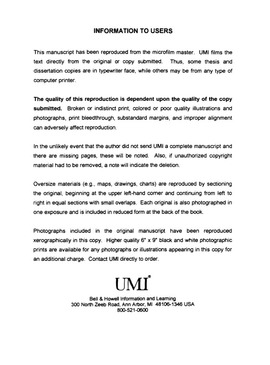| dc.contributor.advisor | Gardner, James E., | en_US |
| dc.contributor.author | Fields, Sara L. | en_US |
| dc.date.accessioned | 2013-08-16T12:30:37Z | |
| dc.date.available | 2013-08-16T12:30:37Z | |
| dc.date.issued | 1999 | en_US |
| dc.identifier.uri | https://hdl.handle.net/11244/5845 | |
| dc.description.abstract | Assistive technology was found to impact the educational environment in many ways. Communication and computer use were the areas where the most significant impact was observed in Travis' educational program. Technology use also impacted affective issues, such as motivation and self-esteem. In addition, the expectations and beliefs of significant others were positively impacted by Travis' technology use. Technology was found to have little effect on his curricular goals, social interaction, or inclusion. | en_US |
| dc.description.abstract | The provision of augmentative and alternative communication devices and materials, when properly implemented, provided some opportunities for increased communication. However, little effort by the staff to keep the devices or materials accessible to Travis (within his reach), and inconsistent reinforcement by the staff for the use of those materials was noted as an inhibiting factor. | en_US |
| dc.description.abstract | A number of recommendations for practice were suggested, including the need for proper training of both certified and noncertified staff members. | en_US |
| dc.description.abstract | Travis' assistive technology preferences included picture icons and low-tech devices (such as loop tapes or single-switch activities). Effective computer access was accomplished by single switch adaptations, and Travis was highly motivated by autonomous computer use. Travis' performance during structured learning activities at the computer, however, showed great variability. Significant oppositional behaviors occurred at times, particularly when the assigned task was developmentally inappropriate, when communication efforts went unrecognized, or when Travis' control options were limited. Teachers who used techniques designed to enhance intrinsic motivation saw significantly better attention to task, perseverance, and cooperation from Travis. | en_US |
| dc.description.abstract | This case study examined the impact of technology use by a student with severe and multiple disabilities on factors such as achievement, learning, inclusion, social interactions, motivation, behavior, self-esteem, or the attitudes of significant others (teachers, peers, etc.) in the educational setting. Qualitative methodologies were used to follow the educational activities of Travis, an 11-year old student entering the 4th grade, for a seven month period. Because of severe limitations in the areas of communication, mobility, cognition, range of motion, and motor skills, Travis was a prime candidate for assistive technology. | en_US |
| dc.format.extent | x, 185 leaves : | en_US |
| dc.subject | Education, Technology of. | en_US |
| dc.subject | Educational technology. | en_US |
| dc.subject | Education, Elementary. | en_US |
| dc.subject | Self-help devices for people with disabilities | en_US |
| dc.subject | Education, Special. | en_US |
| dc.title | The effects of technology use by an individual with severe or multiple disabilities within the educational environment: A case study. | en_US |
| dc.type | Thesis | en_US |
| dc.thesis.degree | Ph.D. | en_US |
| dc.thesis.degreeDiscipline | Department of Educational Psychology | en_US |
| dc.note | Chair: James E. Gardner. | en_US |
| dc.note | Source: Dissertation Abstracts International, Volume: 60-06, Section: A, page: 1979. | en_US |
| ou.identifier | (UMI)AAI9935532 | en_US |
| ou.group | Jeannine Rainbolt College of Education::Department of Educational Psychology | |
